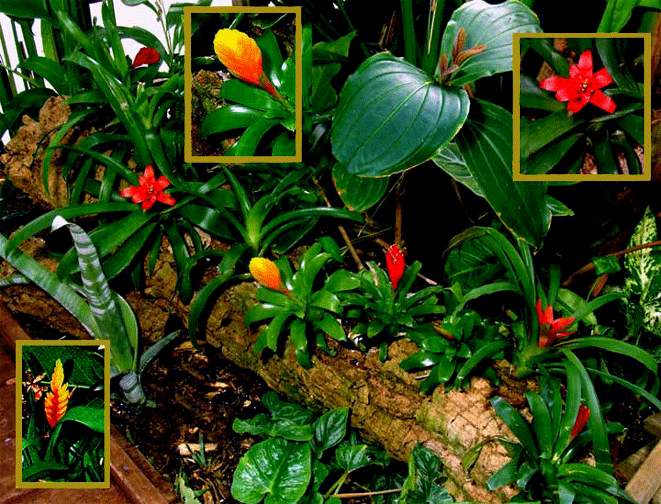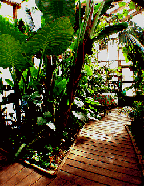![]()
Aroids and other genera in the Collection
Take the Tour Now?
Orchids
The
Exotic Rainforest
The images on this website are copyright protected. Please contact us before any reuse.
A Bromeliad Log

One of our Bromeliad logs
Spring can't be far away once the bromeliads begin to burst open their wildly colorful inflorescences! Some bromeliads are terrestrial and grow in the ground. Most of the species we love normally grow up in the branches of trees as epiphytes. If you're interested in finding out how they get on the branches up in the trees read this link: http://www.exoticrainforest.com/Bromeliads%20pc.html.
We have dozens of bromeliad hybrids growing like they do in nature on "fake logs". If you haven't read any of my explanations about "fake logs" these are our artificial "fallen trees" created by wrapping rolled cork bark around 4 inch PVC pipe and attaching it with screws. The pieces of PVC are then assembled wherever we want a log. The idea was borrowed from a display at Fairchild Tropical Gardens in Miami. Once the log is in place epiphytic plants such as bromeliads and orchids are attached with Liquid Nails original formula glue. In about 6 months the bromeliad "hold fasts" begin to attach the plant naturally . The "hold fasts" appear similar to root systems but do not serve any purpose other than to attach the plant. Once the hold fasts attach the plant grows and reproduces on the log just as they would if they were in the jungles of South America or the Caribbean.
It has now become almost impossible to
accurately identify many bromeliads available for . The
majority available at nurseries are not species but hybrids produced
by crossing species such as Nidularium sp, Vriesea sp., Neoregelia
sp., Billbergia sp. and others. Most are produced by tissue
culture (cloned) at a variety of plant labs. Still, they are
wonderful plants and produce beautiful inflorescences (flowers) that
will continue to reproduce as they would in nature. The majority of
ours are now second generation and were grown as pups from plants we
d and attached several years ago. Once the inflorescence is
spent (which can be months) the plant will begin to produce pups
(baby plants) which are already attached to the "log". Since the cork
is not affected by water we can mist the bromeliads often in to
keep their cones filled with fresh water. Since the plants don't
have root systems they get all their water and nourishment from the
rain water that collects in the cone. To keep them healthy make sure
their cone always has clean water. If you are interested in
bromeliad
 species and their care I suggest you visit The
Bromeliad Encyclopedia
http://fcbs.org/
and it's subsite
"Uncle Derek Says"
http://fcbs.org/butcher/dereksays.htm
Australian bromeliad expert Derek Butcher has spent over
20 years as a self-claimed "pseudobotanist" learning and writing about
bromeliads. His site has hundreds of species photos and a wealth of
technical species information.. He is well known in Australia for his
book on bromeliads.
species and their care I suggest you visit The
Bromeliad Encyclopedia
http://fcbs.org/
and it's subsite
"Uncle Derek Says"
http://fcbs.org/butcher/dereksays.htm
Australian bromeliad expert Derek Butcher has spent over
20 years as a self-claimed "pseudobotanist" learning and writing about
bromeliads. His site has hundreds of species photos and a wealth of
technical species information.. He is well known in Australia for his
book on bromeliads.
I make no claim to any form of bromeliad expertise other than to successfully grow them We simply enjoy watching them grow, reproduce and bloom as naturally as possible. We believe the laterally striped terrestrial bromeliad at the front left of the log to be Billbergia zebrina, the Queen's Tears bromeliad. When mature it will produce an inflorescence of colorful hanging tear shaped brachts that is quite beautiful. The plant was a gift from plant nut.
Directly behind the bromeliad log
grow our large leaf Alocasia odora. The photo can take you
there.